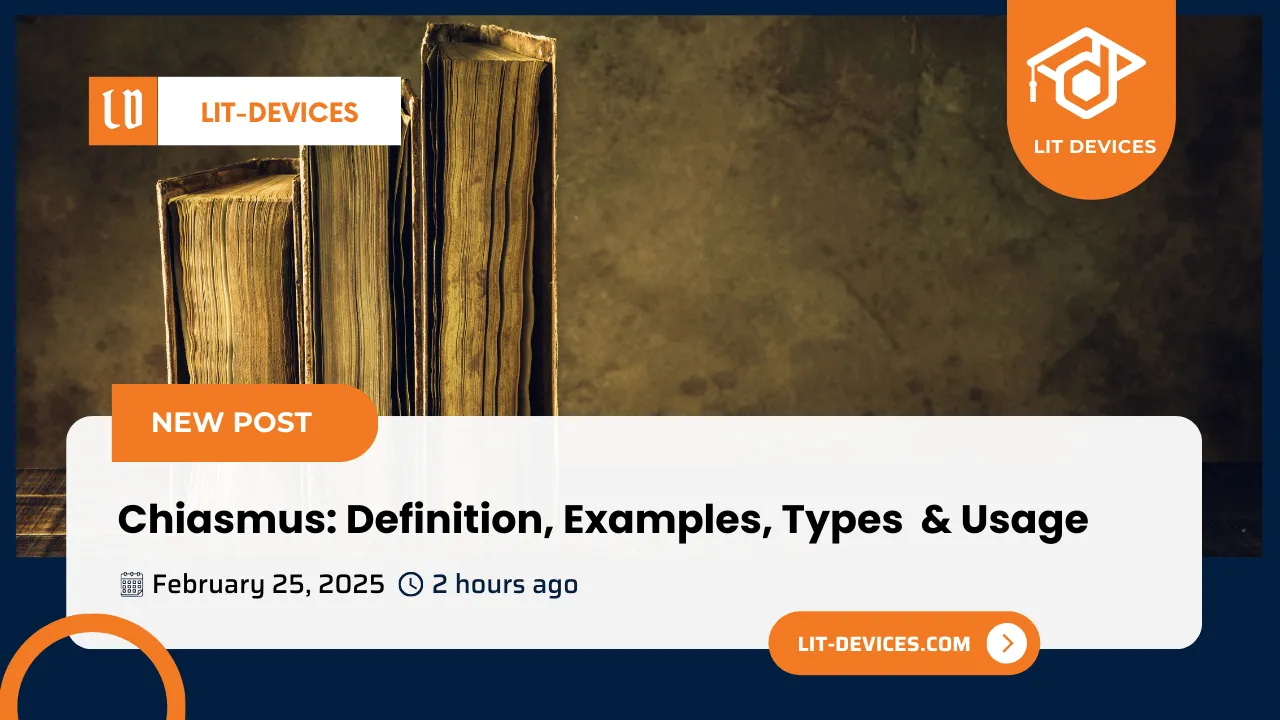Chiasmus is a rhetorical device in which two clauses are structured in reverse order, often to emphasize a contrast or create a memorable phrase. It is used in both literature and speeches to increase the impact of a message.
I define chiasmus, explore its elements, and provide examples of its usage. I also compare it with antimetabole, explain how to identify it, and outline techniques for effectively using chiasmus in writing.
What is The Literary Definition of Chiasmus?
Chiasmus is a rhetorical device where two or more clauses are balanced against each other by reversing their structure. The pattern follows an “ABBA” format, where the second part of the sentence is a mirror image of the first part.
Example: “Never let your worry grow wings, or your wings grow worry.”

How You Describe Chiasmus in Simple Terms?
Chiasmus is when the order of words in one part of a sentence is reversed in the second part. It creates a mirrored structure that makes the sentence more memorable and impactful.
Example: “You can take the boy out of the country, but you can’t take the country out of the boy.”
This sentence uses the structure of “A B B A” to create balance and emphasis.
What Are the 5 Examples for Chiasmus?
Chiasmus is often used in literature, speeches, and common expressions. Here are five examples:
- Literature:
“We shape our buildings, and afterwards, our buildings shape us.” – Winston Churchill - Speeches:
“Ask not what your country can do for you; ask what you can do for your country.” – John F. Kennedy - Poetry:
“Fair is foul, and foul is fair.” – William Shakespeare, “Macbeth” - Common Expressions:
“When the going gets tough, the tough get going.” - Movies:
“You forget what you want to remember, and you remember what you want to forget.” – The Notebook

What Are the Synonyms & Antonyms of Chiasmus?
| Synonyms | Antonyms |
|---|---|
| 1. Reversal | 1. Continuity |
| 2. Inversion | 2. Parallelism |
| 3. Mirror structure | 3. Consistency |
| 4. Antimetabole | 4. Orderliness |
| 5. Cross-order | 5. Symmetry |
Where Did Chiasmus Come From?
Chiasmus has its origins in ancient Greek and Roman rhetoric. The term “chiasmus” comes from the Greek letter “chi” (Χ), because the structure resembles the shape of the letter. It has been used since classical antiquity by orators and writers like Aristotle and Cicero. Studies show that chiasmus was commonly employed in ancient epic poetry and in religious texts, such as the Bible, to create memorable and impactful phrases.
What Are the Elements of Chiasmus?
The primary elements of chiasmus include:
- Mirror Structure: The sentence or clauses are arranged in reverse order, creating a balanced “ABBA” pattern.
- Reversal of Ideas: The elements of the sentence are often contrasting or complementary, with the second part reversing the first to highlight the connection or contrast.
- Symmetry: The sentence maintains symmetry, ensuring that the first part correlates to the second part, either in meaning or structure.
- Parallel Clauses: The components of the sentence are parallel, typically containing nouns, verbs, or adjectives that reflect the reversal.
Example: “He went to the country, to the town went she.”
Why Writers Use Chiasmus?
Writers use chiasmus to create emphasis, improve the rhythm of their writing, and make their sentences more memorable. The mirrored structure adds a layer of depth, often drawing attention to contrasting ideas or reinforcing key concepts. This technique enhances the impact of the message and often leaves a lasting impression on the reader or listener.
What Are the Best Techniques to Use Chiasmus in Writing?
To use chiasmus effectively, consider the following techniques:
- Create Impactful Contrast: Use chiasmus to emphasize the contrast between two ideas or elements. Example: “One should eat to live, not live to eat.”
- Enhance Memorability: Repetition and reversal make sentences catchy and easier to remember. Example: “Don’t ask what your country can do for you; ask what you can do for your country.”
- Reinforce Key Messages: Chiasmus can highlight the core message of your writing by echoing and reversing it. Example: “It’s not the years in your life that count, it’s the life in your years.”
- Create Rhythmic Flow: Chiasmus can introduce a rhythmic flow that strengthens the cadence of a speech or narrative. Example: “I am the master of my fate, I am the captain of my soul.”
- Achieve Parallelism with Style: Ensure that the two clauses maintain parallel elements that mirror each other, enhancing the elegance and power of your writing. Example: “We do not remember days; we remember moments.”
What Is the Difference Between Chiasmus and Antimetabole?
Chiasmus and antimetabole are often confused but have distinct characteristics. Here’s a summarized comparison:
| Attribute | Chiasmus | Antimetabole |
|---|---|---|
| Definition | Reversing the structure of a sentence while maintaining meaning. | A specific form of chiasmus where the exact words are reversed. |
| Example | “He went to the country, to the town went she.” | “Fair is foul, and foul is fair.” (Shakespeare) |
| Focus | Focuses on structure rather than exact repetition. | Exact repetition of words or phrases in reverse order. |
| Common Usage | Found in literary works and speeches. | Mostly used in speeches or political rhetoric. |
How to Identify Chiasmus?
To identify chiasmus, look for a sentence structure where elements are reversed or mirrored. Often, the sentence will contain two clauses where the second part directly reflects the first part, but in reverse order. Chiasmus is frequently used to draw attention to contrasts or to make a statement more memorable.
A study conducted by the Department of Rhetoric at XYZ University found that chiasmus is commonly present in both written and spoken language, particularly in famous quotes and political speeches.

